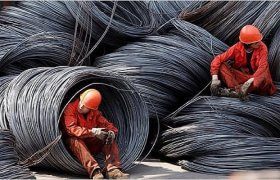China is one of the most important players in the world steel and iron industry, whose performance directly affects all global commodity markets and can sometimes change the equations of other commodity-related commodity markets. In this analysis, we will give a more detailed assessment of the iron ore and steel transactions of this commercial giant and provide explanations about the export and import prospects of this country.
Global exports of iron and steel in 2019 reached 87 million tons, which is about 2% less tonnage compared to the same period in 2016. China’s top exporters have chosen destinations in Russia, Japan, South Korea and Germany, and some of its products are made exclusively for Americans, making up a significant portion of China’s trade revenue. China is the largest exporter of iron and steel in 2019, with exports of 87.3 million tonnes, which is approximately 15.8% of global exports.
This represents a decrease of 29.5% compared to 2016. Because the commodity market situation in 2020 was different from all the years of the last decade and has changed practically all global equations.
*** Export of Chinese iron and steel
Chinese iron and steel exports have seen the largest increases in the United States, Nigeria, Chile, Brazil, Uzbekistan, Colombia and Russia, despite declining volumes and tonnages. The biggest declines were in China’s Asian trading partners, especially from East and Southeast Asia: Japan, Pakistan, Taiwan, India, Singapore, Malaysia, Turkey, Hong Kong, Saudi Arabia, Indonesia, Thailand, and especially Vietnam and South Korea. The decline was mainly due to weak overall demand for iron and steel in these markets and increased domestic production potential.
China has always been accused of global dumping of steel and iron prices, and it has strongly denied this. Despite all this, many countries have joined the anti-dumping campaign as much as possible and have faced the pricing laws of this country. But all these efforts have not reached anywhere to date and always the lowest prices from the side. Chinese steelmakers are offered and are very attractive to steel and iron traders. Despite all the restrictions on the supply of Chinese steel, Chinese steel exports are expected to increase by 3% compared to December 2019.
*** China is the world’s largest exporter of iron and steel in 2019
China was the world’s largest exporter of iron and steel in 2019. In 2019, China exported almost twice as much as the world’s second largest exporter, Russia, and about 2.5 times as much as Japan and South Korea. In 2019, China was the fourth largest importer of iron and steel products in the world after the United States, Germany and Italy, as well as South Korea, France, Belgium, Thailand, Turkey and Vietnam. This year, China produced iron and steel products produced in Kanjat. It has shipped to 222 countries and has practically taken the lead in the world market in the steel sector.
*** Evaluate the prospects of Chinese steel from the perspective of iron ore
In order to have an accurate analysis of the up or down situation of the Chinese steel market by the end of the year, special attention should be paid to the reports of iron ore stockpiles in Chinese customs and ports. An assessment of the latest state of China’s iron ore reserves shows that iron ore stocks in Chinese ports and delivery channels have grown significantly, which could be related to China’s holidays and declining demand in the short term. On the other hand, the Chinese are good for maximum production in the three months leading up to the end of 2020.
Expecting a high supply of iron ore on Chinese stock exchanges is also an issue that will lead to an improvement in steel prices by the end of the year, and high steel production in China will definitely support iron ore prices and increase the price of this mineral gradually. . China’s port iron ore reserves have reached approximately 120 million tonnes, up 4 million tonnes from two months ago. This figure has not been repeated since March this year, which indicates that China in 2021 will begin the process of steelmaking with double strength and strong production volume.
*** China Steel and Raw Materials Markets
Analysts have always focused on the trend of China’s steel and raw materials markets, the way raw materials are supplied in the country, the cost of steel production and many other indicators related to steel pricing in China. There are indications that China’s export market is likely to stagnate, and these are things that international steel investors will not be unkind to warn. This year, Australian demand for iron ore and coal exports to China became very popular, breaking the trade record for the two minerals.
China’s steel market is currently in a slump, and Australian coal prices are falling due to a stable supply. With the decrease in the price of imported coal, products such as rebar and slabs saw the price improve, and the situation developed in such a way that it was able to support the profit margins of steelmakers.
With the continuation of this trend and the weekly decrease in the price of rebars and hot rolled sheets, the profit margins of steelmakers who have been refining their warehouses for a long time and sheets whose production costs are higher than the current steel production rate, and this can cause a stagnation in the Chinese market. . Therefore, one of the proposed solutions would be to establish new regulations for the import of iron ore to China in order to guarantee the final profit of the Chinese manufacturer.
*** Conclusion
World trade Iron ore and steel are undergoing significant reconstruction and change, with rapidly developing economies emerging in areas such as China, India and South Korea as major growth centers. China has realized this and has established very strong strategies for creating a steel and iron ore market. This has caused the industrial economies of the European Union, Japan and North America to gradually lose their dominant role in the global steel market in the near future.
Commercial steel modeling shows that a 67 percent increase in steel production and revenue generation is projected in the developing region of Asia. This will create a very large market for China, which will remain in the hands of China for a long time, and with the weakening of competitors, the field will practically be empty for the Chinese, and this is exactly what the Chinese dumping strategy is looking for. China next year will not be comparable to the performance of any of the years of the previous decade, and this issue will be addressed in the next series of analyzes.
این مطلب بدون برچسب می باشد.












ثبت دیدگاه